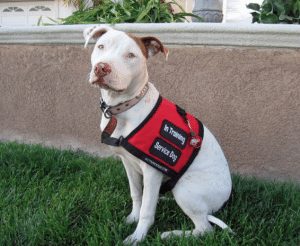Daniel Jacob is a writer, guide-dog user and Montrealer. He has shared some important information with us in the past – like: service-dog etiquette and a Q&A session about guide-dogs. Have you ever wanted to foster a service puppy or simply wondered how puppies become guide-dogs? Daniel’s back – with some more interesting insights…
About guide-dog training specifically – I can tell you that most if not all dogs are now trained under the marker or clicker system. (For more information on this system and how it works, click here).
Most puppies leave their respective kennels between 8 and 12 weeks of age, depending on individual schools and policies therein. It goes without saying that this will also vary depending on the availability of foster homes. Homes with families are generally sought out rather than single homes, as it is best for the dog to be socialized with a number of people and exposed to as many possible working situations as possible for the dog’s 12 to 15 months in the foster home. I have heard it said that some school boards have instituted a “bring your pet to school day”, specifically for this purpose. Some guide-dog schools like Guide Dogs for the Blind have “Puppy Love” days where they invite the public to meet and cuddle potential guide-dog puppies – and find out about the school.

These special days are also held in an attempt for trainers to judge puppies’ ability to handle excessive handling and to see whether they’ll behave properly when faced with human attention according to how they were taught. Foster families are absolutely required to attend pre-paid obedience courses as well as evaluations according to individual school specifications. Don’t worry! The school to which you are applying your family’s foster services will make their directives clear and well known. I can assure you that failure to follow them to the letter will result in removal of the puppy.
These dogs cost thousands of dollars and schools aren’t likely to mess around with you. The good news though, is that your dog food as well as any necessary medical treatment will be covered by the school.
While foster families are required to teach their charges not to pull, they are asked not to teach their dogs the heel command. This is because the guide-dog heel is different from the traditional heel. The traditional heel requires that the dog’s right front foot is at your left foot, whereas the guide-dog heel requires your left foot to be at the dog’s right hip. Guide-dog schools don’t want this heel to be taught, before the dog’s level of dominance is evaluated.
Teaching this heel to an overly dominant dog will make it almost impossible to get it to stop pulling…almost. Also, a dog that walks in front is more likely to forage, or scent mark, depending on its age and maturity, of course. The pack leader walks in front, remember? Though we can make a pretty good educated guess as to a dog’s rank drive from a relatively early age, most dogs come into the peak of their character cycle at about a year old. By this time, they most likely have already been spayed or neutered and are entering their final tests for psychological, physical or neurological disorders. The age the dogs start formal training will depend on three things. Their level of energy, available trainers and obviously, their evaluations.
Daniel Jacob is currently working on a dog training book – and we wish him the best of luck!
To find out more about fostering service puppies,check out these resources:
- Dog Guides of Canada
- Mira Foundation
- Here’s a story we featured about a local Autism service dog
 Montreal Dog Blog Montreal's Online Dog Park
Montreal Dog Blog Montreal's Online Dog Park



